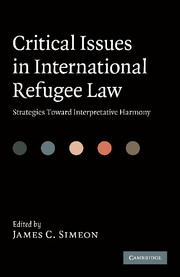Book contents
- Frontmatter
- Contents
- Notes on contributors
- Foreword by Justice Tony North
- Acknowledgements
- Introduction
- Chapter 1 From refugee to judge of refugee law
- Chapter 2 Individual risk, armed conflict and the standard of proof in complementary protection claims:
- Chapter 3 Running scared since 9/11:
- Chapter 4 Asymmetrical sovereignty and the refugee:
- Chapter 5 Economic harm as a basis for refugee status and the application of human rights law to the interpretation of economic persecution
- Chapter 6 The fragmented nature of the international refugee regime and its consequences:
- Index
- References
Chapter 2 - Individual risk, armed conflict and the standard of proof in complementary protection claims:
the European Union and Canada compared
Published online by Cambridge University Press: 17 February 2011
- Frontmatter
- Contents
- Notes on contributors
- Foreword by Justice Tony North
- Acknowledgements
- Introduction
- Chapter 1 From refugee to judge of refugee law
- Chapter 2 Individual risk, armed conflict and the standard of proof in complementary protection claims:
- Chapter 3 Running scared since 9/11:
- Chapter 4 Asymmetrical sovereignty and the refugee:
- Chapter 5 Economic harm as a basis for refugee status and the application of human rights law to the interpretation of economic persecution
- Chapter 6 The fragmented nature of the international refugee regime and its consequences:
- Index
- References
Summary
Introduction
Though the title of this chapter implies a technical and comparative legal analysis of the standard of proof in complementary protection claims vis-à-vis Convention refugee claims, this is only part of its substance. Indeed, while the standard of proof has become a central distinguishing feature in the Canadian context between attaining protection as a ‘refugee’ or as a ‘person in need of protection’, this debate has been largely absent from the EU arena. Nevertheless, high evidentiary burdens, combined with a haphazard consideration of the three possible grounds for subsidiary protection in the EU, mean that as in Canada, subsidiary protection status is not simply a residual status for people who would be Convention refugees but for the absence of a nexus with one of the five Convention grounds. Accordingly, this chapter focuses on the legal impediments to obtaining subsidiary protection in the EU that have manifested themselves since the Qualification Directive entered into force for the EU Member States in October 2006. Its particular focus is article 15(c), which extends protection to civilians facing ‘a serious and individual threat to their life or person by reason of indiscriminate violence in situations of international or internal armed conflict’. This provision has been poorly understood, inconsistently applied across the Member States, and in some jurisdictions is the only subsidiary protection category given full consideration when a Convention claim fails.
- Type
- Chapter
- Information
- Critical Issues in International Refugee LawStrategies toward Interpretative Harmony, pp. 59 - 84Publisher: Cambridge University PressPrint publication year: 2010
References
- 2
- Cited by

